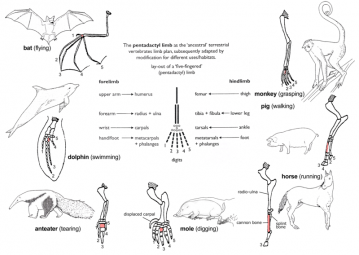Summary of problems:
We determined above that homology, as defined by Darwin, is similarity in structure and position that occurs because species share a common ancestor that also exhibited the basic structural motif. If the similarity is not due to common ancestry, the structures would not be homologous. As Wagner (1988) pointed out, homologs are expected to have a similar position with respect to other structures in different species and their component parts are expected to have a similar position with respect to each other. Furthermore, homologs should be historically contingent in the sense that common descent is the only way to explain the presence of this invariant feature. Hence, before structures meet the criteria for homology, biologists evaluate alternative explanations of similarity, in particular, similarity as a result of function, common materials, and/or limitations of design.
Full discussion:
The authors of Explore Evolution provide their evidence on pages 46-47 that function rather than ancestry may better explain the humerus-radius-ulna pattern of the vertebrate limb. Specifically that it s a functional optimum for vertebrates with limbs to have one bone, the humerus, in the part of the limb closest to the trunk (body) and two bones, the radius and ulna, in the next portion of the limb. If the arrangement were reversed, functional problems would arise, particularly with range of motion.
The example the authors use to explain the restrictions placed on the two-to-one arrangement involves exploring the two differing arrangements using a ball of clay and two straws. However, a serious design flaw occurs when using their model. The example may recreate the structural arrangement of the bones, but provides an incredibly inadequate model of the connections between the bones. The ball and socket arrangement of the humero-scapular joint, the pivot of the radius-ulna, the hinge of the humero-radial joint are all important in determining function. Hence to really test their hypothesis, that function would be limited given another arrangement of bones, we would also have to rearrange the points of connection, which I suspect would rectify the problem. After all, the two-to-one arrangement works fine for the forearm, and allows the radius and ulna to rotate around the humerus.
Another problem with the authors argument is that vertebrate forelimbs actually function in a wide variety of habitats including running on land, swinging in trees, flying in the air, swimming in the water, and as the case is with penguins, flying in the water. It hard to believe that each of these habitats would place the exact same functional requirement on the design of the vertebrate limb. And in fact, to accommodate these different functional requirements, vertebrate limbs show incredible modifications. For example, the horse has a fused radius and ulna (see figure below), disproving the hypothesis that the one-two arrangement is a result of functional optimization for each vertebrate species. In fact, the vertebrate forelimb provides an amazing example of how function has influenced modifications to the same h-r-u pattern.
 Homology of vertebrate limbs: Image produced by Jerry Crimson Mann, and released under the GFDL.
Homology of vertebrate limbs: Image produced by Jerry Crimson Mann, and released under the GFDL. The pattern of limb bones called pentadactyl is found in all classes of tetrapods (i.e. from amphibians to mammals). It can even be traced back to the fins of certain fossil fishes from which the first amphibians are thought to have evolved. The limb has a single proximal bone (humerus), two distal bones (radius and ulna), a series of carpals (wrist bones), followed by five series of metacarpals (palm bones) and phalanges (digits). Throughout the tetrapods, the fundamental structures of pentadactyl limbs are the same, indicating that they originated from a common ancestor. But in the course of evolution, these fundamental structures have been modified. They have become superficially different to serve different functions in adaptation to different environments and modes of life. This phenomenon is clearly shown in the forelimbs of mammals. For example:
- In the monkey, the forelimbs are much elongated to form a grasping hand for climbing and swinging among trees.
- In the pig, the first digit is lost, and the second and fifth digits are reduced. The remaining two digits are longer and stouter than the rest and bear a hoof for supporting the body.
- In the horse, the forelimbs are adapted for support and running by great elongation of the third digit bearing a hoof.
- The mole has a pair of short, spade-like forelimbs for burrowing.
- The anteater uses its enlarged third digit for tearing down ant hills and termite nests.
- In the whale, the forelimbs become flippers for steering and maintaining equilibrium during swimming.
- In the bat, the forelimbs have turned into wings for flying by great elongation of four digits, and the hook-like first digit remains free for hanging from trees.
